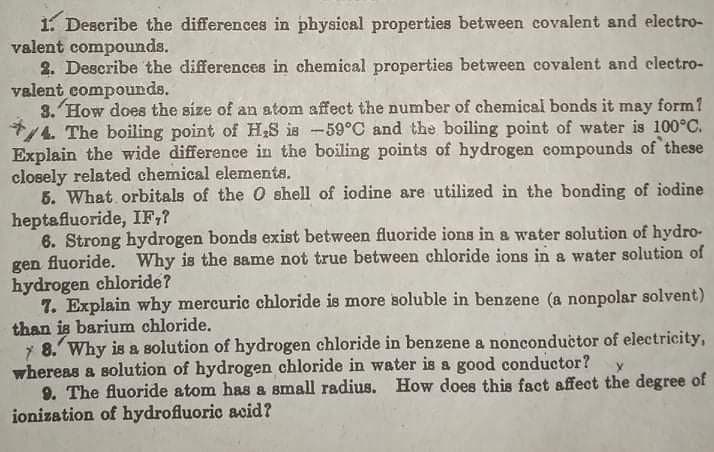1. Describe the differences in physical properties between covalent and electro- lent compounds. 2. Describe the differences in chemical properties between covalent and clectro- lent compounda
1. Describe the differences in physical properties between covalent and electro- lent compounds. 2. Describe the differences in chemical properties between covalent and clectro- lent compounda
Chemistry & Chemical Reactivity
10th Edition
ISBN:9781337399074
Author:John C. Kotz, Paul M. Treichel, John Townsend, David Treichel
Publisher:John C. Kotz, Paul M. Treichel, John Townsend, David Treichel
Chapter24: Biochemistry
Section: Chapter Questions
Problem 20PS: If a drop of oleic acid is added to a dish of water, the oleic acid will spread out and form a layer...
Related questions
Question
Plz solve que 1 and 2 Asap...!

Transcribed Image Text:1. Describe the differences in physical properties between covalent and electro-
valent compounds.
2. Describe the differences in chemical properties between covalent and electro-
valent compounds.
3. How does the size of an atom affect the number of chemical bonds it may form 1
7/4 The boiling point of H;S is -59°C and the boiling point of water is 100°C.
Explain the wide difference in the boiling points of hydrogen compounds of these
closely related chemical elements.
5. What orbitals of the O shell of iodine are utilized in the bonding of iodine
heptafluoride, IF,?
6. Strong hydrogen bonds exist between fluoride ions in a water solution of hydro-
gen fluoride. Why is the same not true between chloride ions in a water solution of
hydrogen chloride?
7. Explain why mercuric chloride is more soluble in benzene (a nonpolar solvent)
than is barium chloride.
7 8. Why is a solution of hydrogen chloride in benzene a nonconductor of electricity,
whereas a solution of hydrogen chloride in water is a good conductor?
9. The fluoride atom has & small radius. How does this fact affect the degree of
ionization of hydrofluoric acid?
Expert Solution
This question has been solved!
Explore an expertly crafted, step-by-step solution for a thorough understanding of key concepts.
Step by step
Solved in 2 steps

Knowledge Booster
Learn more about
Need a deep-dive on the concept behind this application? Look no further. Learn more about this topic, chemistry and related others by exploring similar questions and additional content below.Recommended textbooks for you

Chemistry & Chemical Reactivity
Chemistry
ISBN:
9781337399074
Author:
John C. Kotz, Paul M. Treichel, John Townsend, David Treichel
Publisher:
Cengage Learning

Chemistry & Chemical Reactivity
Chemistry
ISBN:
9781133949640
Author:
John C. Kotz, Paul M. Treichel, John Townsend, David Treichel
Publisher:
Cengage Learning

Chemistry for Engineering Students
Chemistry
ISBN:
9781337398909
Author:
Lawrence S. Brown, Tom Holme
Publisher:
Cengage Learning

Chemistry & Chemical Reactivity
Chemistry
ISBN:
9781337399074
Author:
John C. Kotz, Paul M. Treichel, John Townsend, David Treichel
Publisher:
Cengage Learning

Chemistry & Chemical Reactivity
Chemistry
ISBN:
9781133949640
Author:
John C. Kotz, Paul M. Treichel, John Townsend, David Treichel
Publisher:
Cengage Learning

Chemistry for Engineering Students
Chemistry
ISBN:
9781337398909
Author:
Lawrence S. Brown, Tom Holme
Publisher:
Cengage Learning

Introductory Chemistry: A Foundation
Chemistry
ISBN:
9781337399425
Author:
Steven S. Zumdahl, Donald J. DeCoste
Publisher:
Cengage Learning

Organic Chemistry: A Guided Inquiry
Chemistry
ISBN:
9780618974122
Author:
Andrei Straumanis
Publisher:
Cengage Learning

Introductory Chemistry: An Active Learning Approa…
Chemistry
ISBN:
9781305079250
Author:
Mark S. Cracolice, Ed Peters
Publisher:
Cengage Learning